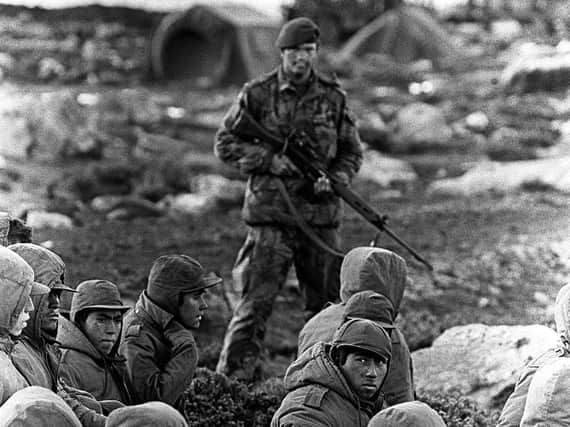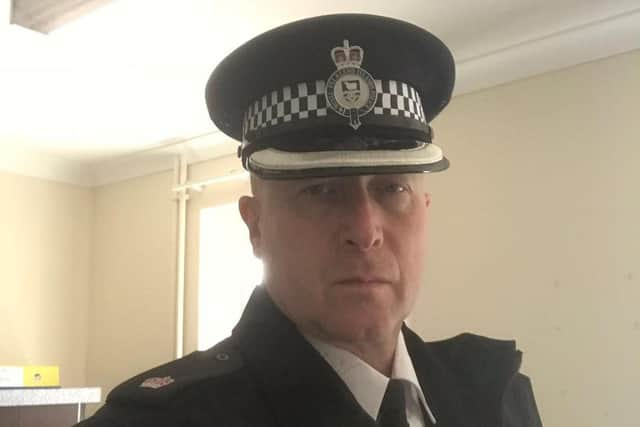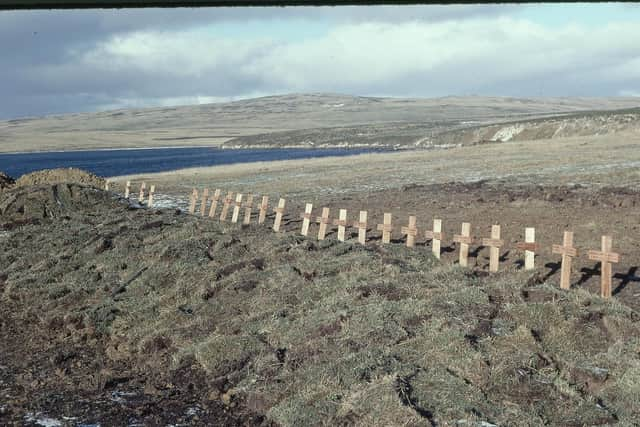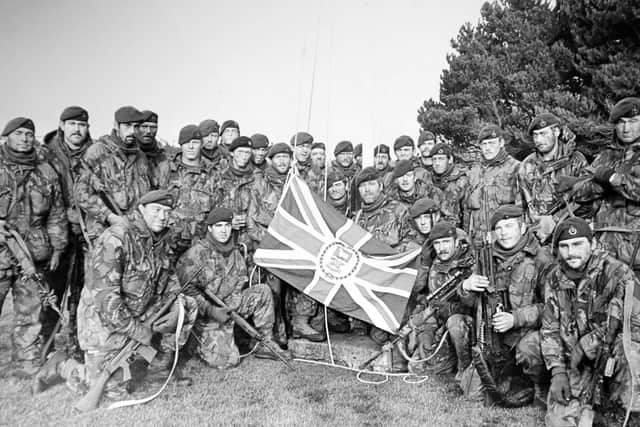Ex-Wigan police boss heads probe into missing Falklands War bodies


Supt Jeff McMahon says that investigations are at an early stage, but credible evidence has been presented which suggests up to 20 bodies were interred near a bay called Teal Inlet.
It has been alleged that the fallen soldiers were interred near to a site where medical waste - included severed combtatants’ limbs - was buried, and while it was done with dignity and a religious ceremony, no markers were put there, and if any documents were sent back to Britain describing the site, then they have so far failed to surface.
Advertisement
Hide AdAdvertisement
Hide AdSo part of Supt McMahon’s inquiry is to appeal to veterans of the South Atlantic conflict and any other witnesses to come forward with information that might corroborate the claims - or otherwise.


The undeclared war raged for 10 weeks, starting on April 2 1982 when Argentinian forces invaded the Falklands, which had been a British Crown colony since 1841. Ownership of the islands had long been a source of dispute, with the Argentinians accusing Britain of seizing the then all but deserted Las Malvinas, as they call it, from them.
Margaret Thatcher’s government dispatched a naval task force to engage the Argentine Navy and Air Force before making an amphibious assault on the islands.
The conflict ended with an Argentine surrender on June 14, returning the islands to British control. In total, 649 Argentine military personnel, 255 British military personnel, and three islanders died during the hostilities.
Advertisement
Hide AdAdvertisement
Hide AdBut not all of the Argentian fallen have been accounted for.


Some unidentified soldiers are buried at an official site in Darwin near Goose Green which in some ways confuses things further because relatives whose sons, husbands and fathers are unaccounted for may think they may in fact be at Teal Inlet.
There have been repatriations of bodies before and finding new graves is an ongoing process, just as it is with regard to far older conflicts, even if in some cases families and politicians are content for the bodies to remain on the islands, not least because the Argentinians continue to regard it as home soil.
But that is not going to stop further inquiries’ taking place if evidence of the graves supports them.
Advertisement
Hide AdAdvertisement
Hide AdSupt McMahon, currently back in Standish with his family, but still the Falklands’ chief of police for the last four years, said: “Last October a retired Marine medical officer contacted the Governor of the Falkland Islands and reported that a number of burials of British and Argentine casualties took place at Teal Inlet and these men remain in situ.


“There was a British burial site at Teal Inlet. The witness claims he did not know where this British site was and only learned there was an official one in 2020. This is commemorated by a plaque.
“He claims a military digger arrived on site, dug a trench and this was used to dispose of body parts removed during surgery at a field hospital set up at Teal Inlet.
“The trench was also reportedly used for burials. All this took place in the final two weeks of the Falklands war, from June 4 to June 14 1982. For some reason though the area was not marked and if a paper record was made then it does not appear to have got back to the UK.
Advertisement
Hide AdAdvertisement
Hide Ad“The majority of casualties arriving at Teal Inlet were from the final iconic battles - such as Mount Harriet, Tumbledown and Wireless Ridge - which took place from June 11 onwards. Both Argentine and British casualties were treated at the field hospital.
“Detectives have spoken to a number of witnesses who corroborated some of the original complainants information. From work so far there is no indication any British casualties were left behind or unaccounted for.”
There is only one Argentine listed as being buried at Teal though: Ramon Quintana.
Retired Colonel Geoffrey Cardoza led a team in 1982/3 to locate and exhume Argentine dead; who were all otherwise interred at the Argentine Cemetery at Darwin. Quintana too was exhumed and reburied.
Advertisement
Hide AdAdvertisement
Hide AdInvestigations continue to locate a possible site at Teal Inlet and the Royal Falkland Islands Police are engaging with the International Commission of the Red Cross (ICRC) for advice and support. (The ICRC are involved in on-going identification work of unidentified Argentine combatants buried at the Argentine Cemetery).
Supt McMahon said: “It remains speculation at this stage but there is a possibility that there is anything between two and 20 Argentine bodies at Teal Inlet.
“There are probably families in Argentina who were told their sons were missing in action who have accepted they are in unmarked graves or the one bearing the plaque at Darwin.
“Identification back then wasn’t helped because the Argentine soldiers didn’t have decent ID, athough in 2017 there were exercises to undetake some DNA testing on bodies at Darwin.
Advertisement
Hide AdAdvertisement
Hide Ad“As far as Teal Inlet is concerned, we have narrowed down the area where the bodies would be to a square of about 50m by 50m. There are processes to go through but we will probably eventually bring in diggers in then ground-penetrating radar.”
If many Argentinian families are satisfied that their loved ones should remain buried on the Falklands, even in unmarked graves, what is the purpose of the exercise?
Supt McMahon said: “It’s humanitarian. It is to continue the work that goes on in terms of processing casualties. It is an extension of exhumations that took place in 1982-3 and further bodies were found in the mid-90s. It is a recurring pattern that will go on far longer than this.
“They are still finding bodies in France dating back from the First and Second World Wars.
Advertisement
Hide AdAdvertisement
Hide Ad“And if bodies are found at Teal Inlet and there are surviving Argentine relatives, they will want to know.
“Some might even think their missing relatives were among Argentina’s ‘Disappeared’ rather than war casualties. With advances in DNA technology, there is a better than ever chance of identifying fallen soldiers and giving families some peace of mind.
“Ultimately what happens to any recovered bodies could be up to surviving family if DNA links can be established. ”
Anyone with information can ring the Royal Falkland Islands Police on 00500 28100 or email [email protected]
Advertisement
Hide AdAdvertisement
Hide AdThe Wigan Observer and Wigan Post are more reliant than ever on your taking out a digital subscription to support our journalism. For unlimited access to Wigan news and information online, you can subscribe at www.wigantoday.net/subscriptions